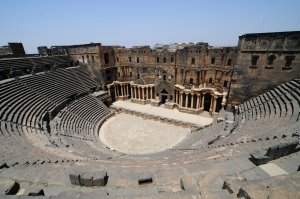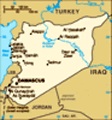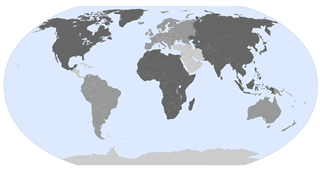Advertisement

 Bosra
Bosra
TheatreAs I was asked to leave the women’s area I whispered to Annina “I am sick and tired of being repressed.” I was inside one of the Muslim worlds most important buildings. You know if you look at all my travels this year. And take the whole believing out of the equation, I’d be a very good Muslim. I have made many unknown pilgrimages to important places in the Muslim world. None more important than Umayyad Mosque in Damascus.
Damascus is Syria’s capital and was my last stop here but in the centre of the country Syria has some real gems. Most of the major sights outside the two big cities are in the middle of the country so a good base and base that most travellers choose is Hama.
Hama is a conservative city that saw a massacre in 1982 from a Muslim Brotherhood. Nowadays it is probably Syria’s most attractive city with many Norias (wooden water wheels) scattered around the cities waters. To me they are not a highlight of the country. But it creates a nice backdrop and peaceful feeling (Despite the forceful creaking noise of the Norias spinning)
On our first night here it was
a Thursday (This part of the worlds Friday.) Sitting up on the roof of our hotel we’d watch the cars drive past and hear them beep their horns past the Clock Tower. Whilst up there Annina and I had our first disagreement about whether the jumping castle in the distance was in fact a jumping minaret for the children. I think it’s pretty obvious that I went with the Jumping Minaret argument. There is a photo to prove my point.
Close by to Hama is a great late afternoon visit to Apanema. An impressive series of ruined columns from a city that once inhabited 500 000 people. It is said that Mark Antony and Cleopatra visited here. But you know, that could be like this nightclub in Buenos Aries that says Diego Maradona goes to this nightclub. It could have been 5 minutes? Named after Seleucus I (former general of Alexander the Great) Persian wife. It’s everything a ruined sight should be. Grand in stature but small enough in distance for the visit to be not overbearing. What was overbearing was the annoying little kid who would annoy us for half the 2km cardo (street) trying to get a
tip by telling us information already in the guidebook. This kid would say “Mr!Mr!Mr!” so many times I got this terrible late 80’s song in my head. “Mr Bobalina Mr bobdodalina…”
The next day was the longest in Syria starting from Hama and ending in Palmyra. In between was Krak Des Chevaliers. This castle was described by TE Lawrence as ‘the finest castle in the world’ and replicated by every other travel writer that is famous. But to me at this stage I was slightly disappointed, it’s nice but the location is up on a hill but too close to the town. To me it takes away the dramatic effect slightly. What it does do is create a great setting to catch up on those missed step classes at the gym. So many steps, so many angles to look at, it is obvious why they say it is the finest castle. But they said that because there was no one there when they saw it. Krak has its moments of you and the castle but it doesn’t happen for long enough. A place that does give you time to really feel like you are ‘out there’ is Palmyra.
Palmyra is a ruined sight but in the desert. Its famous story is when Queen Zenobia challenged Rome by declaring her lands as independent. Making her own money and fighting in wars. She was described as more beautiful than her ancestor Cleopatra. After some wins over the Roman army she eventually lost out and was paraded around Rome as emperor Aurelian’s prize. She later married a senator and died near Rome.
Now Palmyra is a small town based on tourism. 50 000 population approx. which is built around 500m away from the ancient site. To do this as a day trip or to come during the middle of the day would not give this place justice. Since the site is in the desert the middle of the day is a heatwave. But in the morning and in the late afternoon the pleasant temperatures combine with a tame light to make the ancient town glow with an orange and yellow hue.
If you stay overnight it creates a really chilled out atmosphere and enables a slight attachment to the site. The ancient city is extensive with the main attraction being the Temple of Bel. It is Palmyra’s most complete
structure; Bel was a god of Zeus ilk. The temple is best seen during the late afternoon followed by a 1km walk through Colonnaded Avenue passing more columned beauty to the hills for sunset. A look down at the site from the Valley of Tombs and you’ll have the sun behind you and Palmyra slowly saying goodbye to another night and another lot of tourists. (TIP: If you go to Valley of tombs instead of Citadel there are no tourists.)
One of the great things about this sight and Syria in general is that there are no tourists on mass so there still is the feeling of discovery. When Palmyra was re-discovered by explorers in 1678 by two Englishmen it took until 1751 for an expedition and brief excavations to be done. It was a 5-day journey from civilisation. Even though the felling is not that dramatic there is that element to it. But only in the early morning and sunset.
The only disappointment that I could find was the dodgy effort by the archaeologists in some of the re-building of the site. Some spots seemed patchy and there is not much defined detail left. Most of that
is in Damascus National Museum where most of the remaining interesting pieces stay. They too have been ruined (literally) by some pathetic 14-year old school student’s first sculpturing effort. At least that what it seems.
What they have done is try and give you the overall picture of what the subject is by filling in the gaps. It’s quite sad really - It lessens the experience. And since it is all in Damascus it has left no artistic presence in Palmyra itself. Most of the time in the museum there is no explanation, except explaining that some Italian company is working with Syria to restore - The blue painted piece of foam, glass cased was a real treat!
In Damascus we went to the Umayyad Mosque, this was the first great mosque, which ranks up there with Jerusalem’s Dome of the Rock. Its second only to the holy mosques of Mecca and Medina. Worshipping dates back to 9th century BC. Christianity was the official religion during the Roman Empire and John the Baptist head was said to be held here in a casket. In 636AD Muslims converted the eastern part to a mosque and for 70 years Christians worshiped
in the west. But when Damascus became the capital of the Islamic World the Christians were forced to stop worshipping here.
To get the tickets you need to go to the ‘Putting on Special Clothes Room.’ The mosque was used as the catalyst for every other mosque. 3 Minarets feature and all are named. The most interesting being the Minaret of Jesus - it’s the tallest and called Jesus because local tradition has it that this is where Christ will appear on earth on Judgement Day.
Inside, the Prey Room is covered in red carpet and small Christian like windows near the roof. Down the way is a shrine to John the Baptist. Walking towards the shrine a horrible stench of foot odour reaches the nasal area. I felt as if I belonged here. You see I have had this offensive foot odour ever since my shoes got drenched by the Pilipino seawater and on every occasion since the shoes are left outside.
At the shrine its cased predominately green, 3 sides dedicated to the males. (Females tourists are allowed into this section). Whilst the female quarter is for strictly women. This is where I walked in
and was asked to move to the other side of the cordoned area. See there are some restrictions for men in this culture too.
At the far end of the courtyard is the Shrine of Hussein son of Ali and grandson of the Prophet. He was killed by the Umayyad at Kerbala in Iraq. It attracts many Shiite Muslims (mostly Iran). Ali is regarded as the founder of Shism. There we saw an Iraqi tour group being guided in and going through that loud passionate prey in a completely unfamiliar language. Even now it can be uncomfortable and I could see Annina was more so than me. We were just about to leave after a couple of minutes of observing when the guide made some wise crack, which resulted in a barrel of laughs. One guy then started talking to me. It was a really great uncomfortable moment.
South of Damascus and near the Jordan border is Bosra. Mostly along the way and like in all of Syria. There are posters and billboards of the president and his father. Quite a few of them have him waving. I was wondering; as President do they take lessons on how
to wave properly? Cause if you go too stiff with the arm you look like a manikin then if its too floppy well that’s showing weakness. It’s a delicate issue in this part of the world. Heck Central Asia and Middle East is full of this crap.
Anyway Bosra is famous for its Roman theatre. It is by far the best-preserved theatre I have seen. Built in early 2nd century it could hold 9000 people, 6000 seated. The seats are black in colour with the stage area more orange stone. This gives it something different to the normal ancient theatre sites.
The rest of the stay was just walking around and appreciating the kind nature of the Syrian people and observing the differences we have. Like spotting the Spring Bukin Water bottle which said the water is - ‘The best to prepare baby’s food and conserve his teeth healthily.’ (Notice: His)
I really enjoyed this part of my trip and enjoyed having a travel partner again since it had been some 4 months. Annina even challenged the Pigeon theory saying that Bern has no pigeons and it is from Switzerland and the Swiss are not poor. Gutted,
I came up with this comeback. “Well the theory is based on its economic stability from its natural resources not through its reliance on banks.’ So with that comment the theory is still alive!! (Dribblers from JP2 will know what I’m talking about.)
I enjoyed my stay here despite poopin out like a mezza dish for most of it and putting up with some toilets facing the wrong way… Man that’s annoying I don’t know what the plumbers are thinking but they face the toilet so when you sit down you are looking straight at the tiled wall. The other option is to go side on either way its not comfortable.
The intention to finish off the trip was to go to Quneitra Syria’s part of the Golon Heights, which was bombed out by Israelis and now a ghost city. And also Tishreen (October) War Panorama a North Korean helped memorial of the 1973 war with Israel. It has various demonstrations against Israel. It would have been nice to see what the government is feeding their citizens with. But things didn’t work out that way.
Instead Syria was finished on a high note: I leave it with
this;
Some places in the world just come and go but Syria once left will always find a place in the good memories from any Journey.
Advertisement
Tot: 0.065s; Tpl: 0.014s; cc: 10; qc: 27; dbt: 0.0412s; 1; m:domysql w:travelblog (10.17.0.13); sld: 1;
; mem: 1.1mb






















Maz
non-member comment
am I missing something?
A very nice blog indeed mate :D Just want to point out something for the sake of history. Tha massacre you mentioned was commited by the government against the Muslim Brotherhood who lived in Hama. The Brotherhood was the victim not the executioner. Cheers